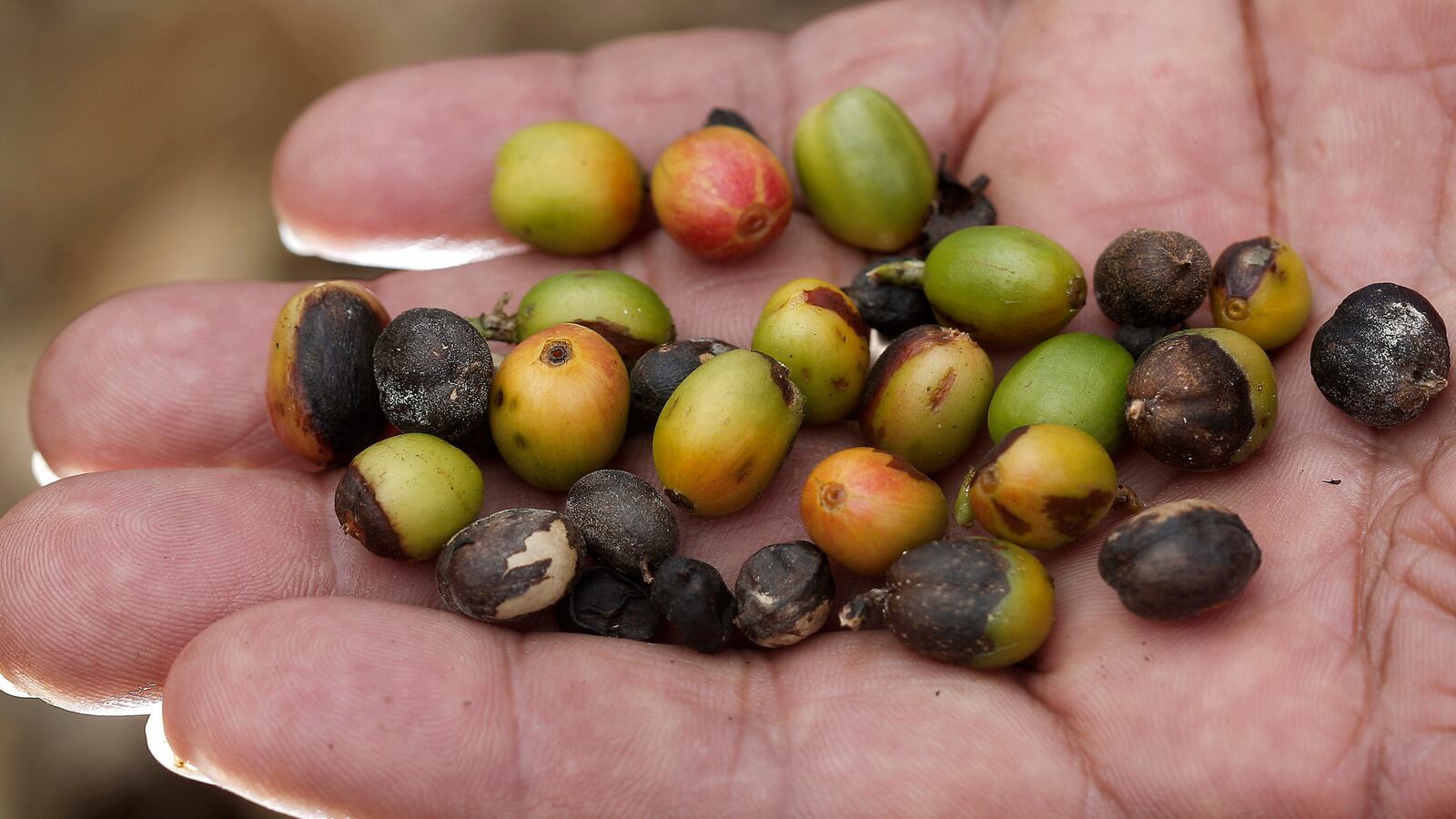SALENTO, Colombia — There’s a constant drizzle, but the tour must go on: Coffee is best picked in light rain, says our host as we step into mud-caked Wellingtons. Tim Harbour, a stocky, middle-aged British man, doesn’t quite fit the mold you’d imagine for a Colombian coffee grower, but that he is. He runs The Plantation House, a farmhouse-turned-guesthouse nestled in the hills of Salento, a cowboy town (sort of) in Colombia’s premier coffee-growing region.

There’s a special aura about the place, like something out of a García Márquez short story where the world outside falls apart, but these green hills remain miraculously unscathed. And so they do. But the reason isn’t magic. It’s a practical question of foresight with an imminently desirable impact: continuing the production of those great Arabica coffee beans you love at Starbucks, at the office, or at the supermarket.
Just to the north of Colombia, the plantations of Central America have been devastated by an aggressive epidemic of coffee rust, a contagious fungus that destroys coffee trees. First discovered more than 150 yeas ago in the Lake Regions of Africa, it has spread relentlessly around the world. But it’s a devastation Colombia predicted and began working to combat decades ago.
Now, as a destroyed crop ruins livelihoods in Central American countries, emerging efforts to combat the destruction are mimicking the success that has placed Colombia in the No. 3 slot of the world’s largest coffee producers, right behind Brazil and Vietnam.
The country’s most famous export is also a selling point for virtually everything in Salento, a village whose Spanish colonial charm has a Wild Western flair. White-washed buildings with blue trim host men clad in ponchos and cowboy hats shooting pool or leaning in doorways, watching the town pass by. Coffee beans are available in jewelry, keychain, soap, body spray and, of course, edible and brewable form.
The bamboo-beamed plantation house of “Don Eduardo” (because “Don Timothy just didn’t sound good,” our host explains, laughing) is perched on a hill above rows of traditional coffee trees slanting down the steep decline. Low-hanging clouds nestle among the layers of mountains; horses and cows graze in the middle distance. Although the farm has had a little rust this year, it has not become a serious problem.
If Colombia’s susceptible plants had been left for the fungus to attack the results would have been catastrophic. The disease has ripped through crops from Guatemala to Costa Rica, wreaking an estimated $1 billion in damages over the past few years, and by late 2013 infected 15 to 20 percent of Central American coffee. According to Ric Rhinehart, executive director of the Specialty Coffee Association of America, it has impacted the coffee industry “in ways we’ve never seen in the past,” sending hundreds of thousands of small subsistence farmers into unemployment and deep poverty.
Meanwhile, Colombia is on track to produce 11.9 million bags in the coming year’s harvest, with only 7 percent affected by rust, thanks to a far-sighted strategy by the Colombian government that has saved the harvests of Colombia’s 500,000 coffee producers.
If they hadn’t moved pre-emptively to stop the fungus, says Rhinehart, “They absolutely would face similar problems right now.”
Back in the 2011 season, the Colombian crop took a nosedive, dropping from 12 million bags to 7.6 million. That year, 40 percent of Colombian plantations were infected with rust, but at the same time, Colombia was ripping out trees “in a massive fashion across the country,” Rhinehart says, and replacing them with millions of the hybrid, resistant variety that the national research organization, Cenicafé, had bred after the country saw as first signs of rust struck in the early ’80s. By 2013, only 5 percent were diseased.
Cenicafé researchers “anticipated climate change would create a scenario where rust was a real pandemic threat,” says Rhinehart.
The Central American epidemic hasn’t hit prices at your neighborhood Starbucks yet, but “it’s definitely getting harder to get top-quality coffees,” says Rhinehart. “When you go into local high-end coffee houses, there are a lot more interesting African, Indonesian, and Colombian coffees on the shelf.” And a lot less from Guatemala or Costa Rica.
Colombia is one of the world’s top suppliers of washed Arabica beans—which are considered the highest quality: milder and less bitter than the lower-grade Robusta beans.
The process of making the best possible coffee is incredibly time consuming. Why is it better to pick the beans in a light rain? Mainly so the rest of the sorting and drying can begin when the downpours get too heavy to be out in the fields. Then there’s the de-skinning, fermenting, drying and quality control before the beans are ready for sale.
After all that steps, 220 pounds of fresh-picked beans will wind up as about 30 pounds of usable product. Even without the threat of coffee rust, it’s an unpredictable market and a tough way to make a living: for every dollar spent on coffee, only 8 cents goes to the farmer.
In Central America, NGOs are attempting to soften the socioeconomic blow against farmers who are seeing their livelihoods threatened. These Band-Aid solutions will have to do for now, as there’s no immediate reversal to the problem of rust. Breeding a resistant strain can take five generations of plants, and 15 years.
Last month, USAID and World Coffee Research (WCR), founded at Texas A&M in 2009, announced a $5 million partnership to combat the rust, hoping to share the kinds of lessons learned in Colombia. “Five years later we’re in a place where all our worst fears had come true,” says Rhinehart, but at least people are getting mobilized. WCR hosted the first International Coffee Rust Summit in April.
At Don Eduardo, Fredy, the leader of the plantation workers, good-naturedly goes through the bean-to-liquid process as we twist our camera lenses into artsy close-ups of the beans piled in their different stages. Water boils in anticipation. A cat snoozes on the stove, and the smell of rain and earth drifting from the groves into the outdoor kitchen mingles with the scent from the brew. After roasting, hand-grinding the beans and seeping the grinds, he hands out steaming cups. “Rico,” he says as we sip. The word—rich, expensive, full-bodied—represents more than just a flavor in Colombia. It’s a more promising future for the country’s hard-working farmers.






